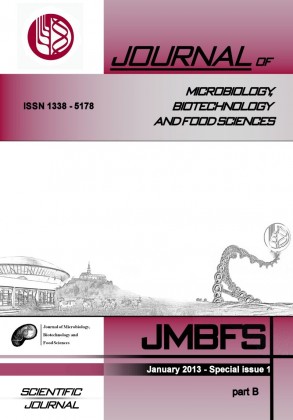BIOACTIVE COMPOUNDS IN COMMONLY UTILIZED LEGUME CULTIVARS FROM IRAQ
Keywords:
fababean, chickpea, lentil, total polyphenol content, total antioxidant capacityAbstract
Total polyphenol content as well as total antioxidant capacity in three chickpea, four fababean and four lentil cultivars from regions of Iraq with different environmental growth conditions were investigated in the work. The total polyphenol content (TP) was estimated using Folin-Ciocalteau assay and the total antioxidant capacity (TAC) of legume extracts was measured using the DPPH spectrophotometrically. The obtained results confirmed that the polyphenols content in the tested legume cultivars was influenced by locality. From tested legumes the highest polyphenol content was measured in fababean (1220 – 6286 mg GAE.kg-1). In lentil (2351 – 3011 mgGAE.kg-1) the average TP value was slightly lower (by 1,6%), while in chickpea (549 – 978 mg GAE.kg-1) it was dramatically (by 71,5%) lower in comparison to fababean. The similar trend was observed at values of TAC. The highest average TAC value was determined in fababean (15.2 – 25.6% DPPH), in lentil (14.2 – 28.9% DPPH) the TAC value was by 2% and in chickpea (1.9 – 4.5% DPPH) by 83,6% lower in comparison to fababean. Only in lentil a statistically strong correlation (P-value 2.391E-06; R = 0.802) was found. Our results confirmed that legumes can be a good source of bioactive compounds in the human nutrition.Downloads
Download data is not yet available.
Downloads
Published
2013-02-01
How to Cite
S. Ismael, D., Vollmannová, A., & Timoracká, M. (2013). BIOACTIVE COMPOUNDS IN COMMONLY UTILIZED LEGUME CULTIVARS FROM IRAQ. Journal of Microbiology, Biotechnology and Food Sciences, 2(special issue 1), 2032–2042. Retrieved from https://office2.jmbfs.org/index.php/JMBFS/article/view/7300
Issue
Section
Food Sciences
License
Copyright (c) 2013 Dalaram S. Ismael, Alena Vollmannová, Maria Timoracká

This work is licensed under a Creative Commons Attribution 4.0 International License.
All papers published in the Journal of Microbiology, Biotechnology and Food Sciences are published under a CC-BY licence (CC-BY 4.0). Published materials can be shared (copy and redistribute the material in any medium or format) and adapted (remix, transform, and build upon the material for any purpose, even commercially) with specifying the author(s).

